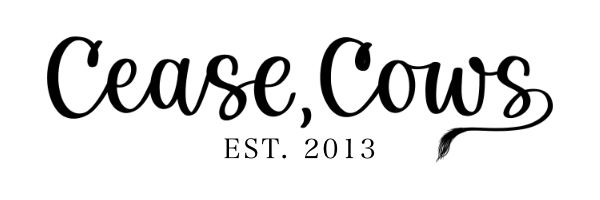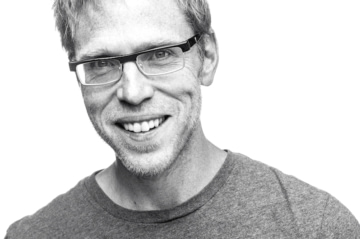Christopher DeWan, whose story “Intrusion” appeared at Cease, Cows earlier this year, has just released a new collection, Hoopty Time Machines, published by Atticus Books. Subtitled “Fairy Tales for Grown-Ups,” DeWan’s fiction is smart, imaginative, and equal parts funny and sad. DeWan’s characters walk the high-wire between aspiration and disappointment, and readers will appreciate the fresh spin DeWan gives to traditional fairy tale forms.
Purchase a copy from Atticus Books or order it from your local independent bookstore. Be sure to check out “Intrusion” for a sample of Christopher’s work.
Christopher recently shared his thoughts with Cease, Cows.
Chuck Augello: How would you describe Hoopty Time Machines to someone who hasn’t read it yet?
Christopher DeWan: Short. Wistful. Intense. Quirky. Fun. I like to warn people that there are no actual time machines in Hoopty Time Machines. I like to tell people this book is a “strange object,” like a stray animal you find in a shoebox on your front porch and you take it and care for it even though you don’t know quite what kind of animal it is. And sometimes I like to tell people it’s a good book to keep in the bathroom, because a lot of the stories are “bathroom-sized.”
CA: Most of the stories are flash fiction, with several being one-page or less. There’s even a one sentence story. What attracts you to writing in this form?
CD: Haha—short attention span? I’ve never been much good at writing New Yorker-length stories. For this book in particular, I wanted to write a set of stories that were very, very distilled, like koans or haiku.
This book relies on a lot of themes and imagery from fairy tales, myths, folktales, and other shared cultural iconography, and that means I sometimes get to use a shorthand: these are things we all know, as a culture, so I don’t have to spend pages describing them. I can get more quickly to the point where I get to subvert or explode them a little.
CA: One of my favorites is the story “Social Media.” Tell us how you came to write it.
CD: I owe this story to a fabulous writer and teacher named Kathy Fish, who leads workshops in flash fiction. She gave a prompt that was essentially, “Can you write a story as a list?”—and what happened here was that I imagined this story, “Social Media,” as a timeline: the series of events that happen on this one terrible day. I wanted to unfurl them one after another in a sequence, but hide the narrator and his connection to the events until the very end.
CA: Many of the stories are about characters trying to escape some aspect of their life. Was that theme intentional when you began writing these stories or did it take shape over time?
CD: As writers, we get a lot of control over a lot of our process, but I’m not sure we get to pick the themes we write about. I just wrote a lot, and the stories turned out to be about this—about people trying to escape, each in their own way. Once I realized that, then it got easier to write and rewrite and figure out which stories belonged in the collection and which ones didn’t.
CA: As a fiction writer, what do you find most challenging?
CD: Paying rent. And then, I think, inducing a kind of trance state that allows me to daydream and write instead of worrying about paying rent.
CA: Hoopty Time Machines is published by Atticus Books. How did you come to publish with them?
CD: I sent out my manuscript for Hoopty Time Machines fully expecting to be told it was unpublishable, and I was completely blown away to learn that a couple different presses were interested in the book—so then I had to pick. It’s a good problem to have, but I had zero experience making that sort of decision. Atticus had already published one of the stories in the book (“The Well”), and the publisher, Dan Cafaro, responded so enthusiastically to the rest of the manuscript.
I discovered Dan and I see very eye-to-eye politically, and that made a difference to me. It’s not super-explicit in the book, but there are a lot of class issues at play in these stories—hope and aspiration and American Dream stuff—and Dan got that. Also, we’re both Mets fans.
CA: When did you start writing fiction? Tell us about your development as a writer.
CD: In fifth grade, I wrote a novel about elves. It’s still available, if anyone wants to publish a novel about elves. It probably needs some work.
CA: Who are some of your favorite writers? Is there a particular book or story that inspires you?
CD: One book I read last year that I can’t get out of my head is a short story collection called North American Lake Monsters by Nathan Ballingrud. It’s beautiful and haunting and unsettling and sometimes downright disturbing. The trick is, even though the stories deal with the threat of monsters in a traditional sense, the real horrors always come from the people. I’d love for this book and this writer to become a household name.
I’m also really excited about a new book by Sequoia Nagamatsu called Where We Go When Where We Were Was Gone. I read partly for pleasure and partly to see what to steal from other writers!—and this book is a book I kind of wish I’d written. I think I’m going to learn a lot from it.
CA: What’s the best writing advice anyone’s given you?
CD: I’ve had so many great teachers over so many years, and what continues to surprise me is how their advice will cycle back and be useful again, years or decades later: lessons that weren’t useful to me at the time become useful when I need them, or when I’m ready for them—and advice I thought I learned before I now get to re-learn in a new way that’s useful to me again now. I’ve been re-reading some of the craft books that have been collecting dust on my shelf and they’re basically brand new to me, because I’m a different person now, and all their wisdom hits me in a different place.
Having said that, the advice I need most right now is just to shut up and write. To write more and get distracted less. So I’ve been setting timers for myself and trying to just plow ahead.
CA: If you suddenly had access to a Hoopty Time Machine, which time period would you choose to visit?
CD: So many answers pop into my head: San Francisco 1849? Fin de siècle Austria? The Grassy Knoll in 1963? Roanoke 1588? The Moon in 1969? Truth is, I’d be really badly equipped to live in any of those places. I’d be badly equipped to live anywhere without WiFi. Also, if this is a “hoopty time machine” like the ones in the book, then no matter where I go, as soon as I get there I’ll discover I’ve brought all of my problems along with me—so I guess the only real answer is that I’d go to the future, and figure out once and for all if it’ll be utopia or dystopia.
CA: Are there new stories in the works? What are you working on currently?
CD: I’ve spent the past few years really focused on screenwriting, especially for television, and that’s what’s taking up most of my brain right now. But I do have a backlog of short stories that are nagging at me to write them, and I’m really looking forward to getting them down on paper soon.
–
Chuck Augello (Contributing Editor) lives in New Jersey with his wife, dog, two cats, and several cows that refuse to cease. His work has appeared in One Story, Juked, Hobart, Smokelong Quarterly, and other fine places. He publishes The Daily Vonnegut and contributes interviews to The Review Review. He’s currently at work on a novel.

